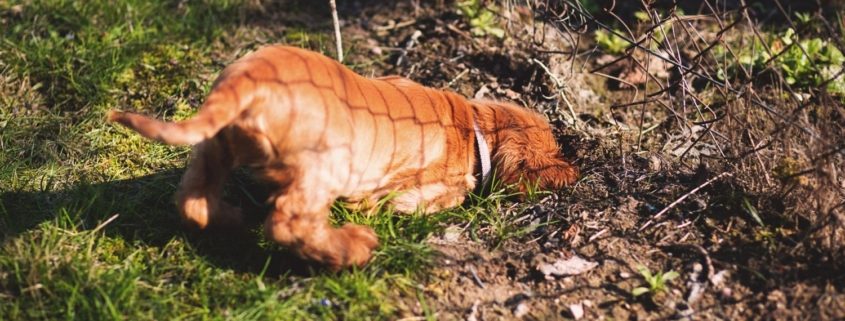Ask Crystal: Destructive Behavior Training
Welcome to “Ask Crystal,” where you can ask your pet behavior questions! You can submit your question for Crystal at the bottom of the page!

Dear Crystal,
I have a 6-month old puppy that is extremely destructive. He literally chews on everything. He has destroyed furniture, flower beds, trees, and every toy we have ever given him. He is also digging up our backyard. Our backyard is just completely a mess. I feel like he must have separation anxiety and that he destroys the yard because he is mad at me for leaving him. He is also very stubborn and doesn’t want to learn anything so I don’t feel like there is anything we can do to teach him to stop. I am at my wits end with this dog. Is there any hope for changing this behavior?
Sincerely,
Frustrated Dog Mom
Dear Frustrated,
Humans often misinterpret dog’s motives for destructive behavior. There are a lot of reasons why a dog might be destructive. This behavior can be caused by certain medical conditions or more commonly a lack of supervision and exercise. It is always a good idea to visit the veterinarian when your dog is having a behavior problem to rule any medical conditions out. Puppies explore the world with their mouths much like a human baby. We seem to understand that babies put everything in their mouth but can’t accept that puppies need to mouth things much more so than a human does. Chewing is a natural dog behavior. There is no way for a dog to know what is ok to chew on and what not to without any guidance. We have to manage the dog’s behavior until they learn which is impossible if they are outside unsupervised.
Management is a huge part of changing behavior. It often feels like people want there be a way to train all the behaviors we don’t like away. Many behaviors can be stopped by managing the dog’s environment and sometimes that is the only thing that needs to be done. In this case, there will likely be more that needs to be done. However, you still need to prevent the dog from practicing the behavior so that it less likely to become a habit. If we catch the dog in the act of chewing something inappropriate, we can either call their name in a happy tone or teach a positive interrupter. You do need to train both behaviors to get the appropriate recall. Start by saying your dog’s name and follow with a treat. The next step would be training when the dog is turned away from you. Call the dog’s name in a high-pitched tone of voice and when his head turns toward you say “yes” and hold a treat by your leg so that he has to come all the way to you. Practice this at the very least ten times a day. The positive interrupter is taught the same way, but you make a noise instead of calling the dog’s name, the noise should always sound the same. The purpose of both is to interrupt the behavior and redirect the chewing on an appropriate toy. When you are not present to interrupt, he should be in a dog proof room with nothing but appropriate toys or in a crate. The idea being to prevent access to inappropriate items as much as possible. Dogs that managed during the first couple years of their life to prevent chewing on appropriate objects rarely are destructive unless there is a big life change. If you want to have a dog that is not destructive, you can’t allow this behavior to continue.
If your dog is 6 months old, that tells me a lot about one main reason why he is chewing on things. Dogs are teething until 18-24 months when their teeth are completely in. They are experiencing gum pain which can be relieved by chewing on things. Simply put, they need to chew on something. Be sure to provide hard chewing toys to ease the pain but if you don’t supervise him, he may not choose those toys over the items in the backyard so providing the toys alone is not enough.
 The other big part of the puzzle is not getting enough exercise. Puppies have an incredible amount of energy. It can seem almost impossible to provide enough exercise, but exercise needs to be more than just leaving the dog outside. Most dogs don’t exercise themselves when left outside, if only it were that easy. The behavior that they usually engage in is exactly what you are describing. They chew on everything; they dig holes and they bark. These are natural behaviors for a dog, we have to redirect their energy onto something that we would prefer they do. Walks are a great way to provide olfactory stimulation which is a great way to enrich a dog’s life. Let your dog sniff to their heart’s content. You probably aren’t going to walk them long enough to burn a significant amount of energy so this may be a more useful way to engage him. If you don’t have a great way to walk your dog everyday don’t despair! I am a huge fan of the flirt pole which is basically like a cat teaser but dog size. It is also a great way to work on impulse control training exercises like wait and drop it. Depending on your dog, you can stand in one spot and just move the toy around and let him have it every once in a while. You don’t want him to become frustrated, so he does need to get the toy sometimes. If he likes to fetch, that can be a great energy burner. Tugging also burns a lot of energy if he enjoys a good tug session. If you have any friends with other friendly dogs, dog play is a fantastic way to tire him out.
The other big part of the puzzle is not getting enough exercise. Puppies have an incredible amount of energy. It can seem almost impossible to provide enough exercise, but exercise needs to be more than just leaving the dog outside. Most dogs don’t exercise themselves when left outside, if only it were that easy. The behavior that they usually engage in is exactly what you are describing. They chew on everything; they dig holes and they bark. These are natural behaviors for a dog, we have to redirect their energy onto something that we would prefer they do. Walks are a great way to provide olfactory stimulation which is a great way to enrich a dog’s life. Let your dog sniff to their heart’s content. You probably aren’t going to walk them long enough to burn a significant amount of energy so this may be a more useful way to engage him. If you don’t have a great way to walk your dog everyday don’t despair! I am a huge fan of the flirt pole which is basically like a cat teaser but dog size. It is also a great way to work on impulse control training exercises like wait and drop it. Depending on your dog, you can stand in one spot and just move the toy around and let him have it every once in a while. You don’t want him to become frustrated, so he does need to get the toy sometimes. If he likes to fetch, that can be a great energy burner. Tugging also burns a lot of energy if he enjoys a good tug session. If you have any friends with other friendly dogs, dog play is a fantastic way to tire him out.
Boredom is related to physical exercise, but mental stimulation is a big part of a happy well-behaved dog. One of the easier ways to provide mental stimulation is through enrichment feeding. You can buy feeders that your dog’s kibble goes into or you can make your own with various paper products. Be aware that this is a learning process for most dogs, so we need to make the toys very easy in the beginning so that the dog learns how to interact without getting frustrated. Often this means placing dry loose kibble in a kong so that it just falls out. You may want to put a little smear of peanut butter to encourage licking the toy.
I highly suggest you join a group training class with him. Training is a great way to mentally stimulate your dog. Beyond that aspect, training provides a common language to share with your dog. You will learn how to teach him cues to manage his behavior and communicate in a common language. A trainer can help you troubleshoot why he might not be picking up on something you are trying to teach him. The Blue Ridge Humane Society offers 8-week Manners 101 classes which are a great place to get started on his training. You can get more information here.
Destructive behavior that is related to separation anxiety often revolves around the owner’s personal items or points of exit. Dogs with separation anxiety often are very destructive with doors, windows and window sills. There are a lot of other severe symptoms associated with this anxiety. Dogs that are housetrained may start to have accidents in the house. They may seem very stressed when you come home. This could manifest as drooling, shaking, or vocalizations. The behavior will occur almost every time the owner leaves and is not present when the owner is home.
It seems the most likely reasons he is being destructive are because he is a teething puppy that is not getting enough exercise and mental stimulation. The good news is that there is hope for changing his behavior. He still young enough that the habits can be changed. It may be a lot of work at first, but I am sure your yard and home will appreciate the work. You will feel less frustrated and your dog will be a happy, better behaved family member.
Until next time,
Crystal







